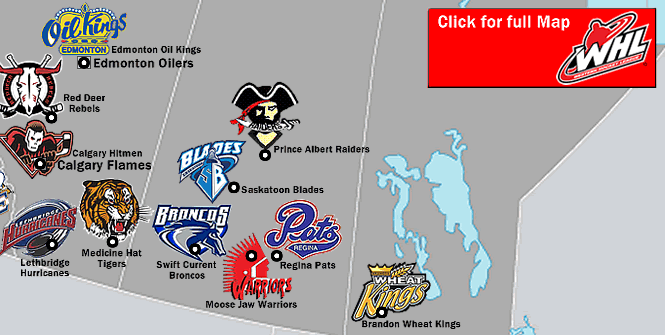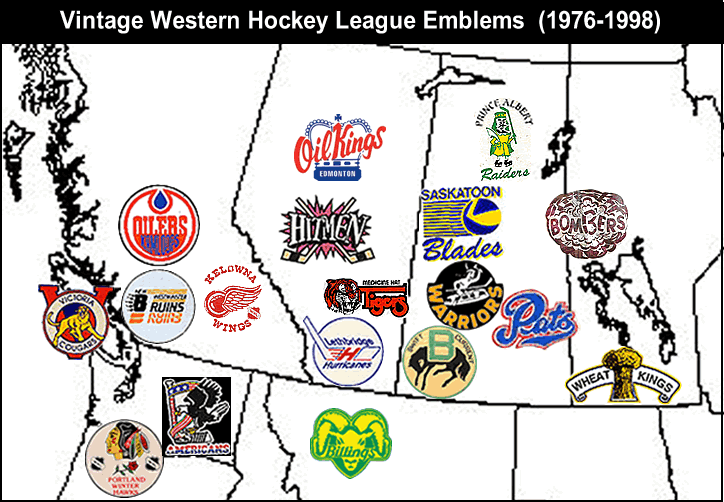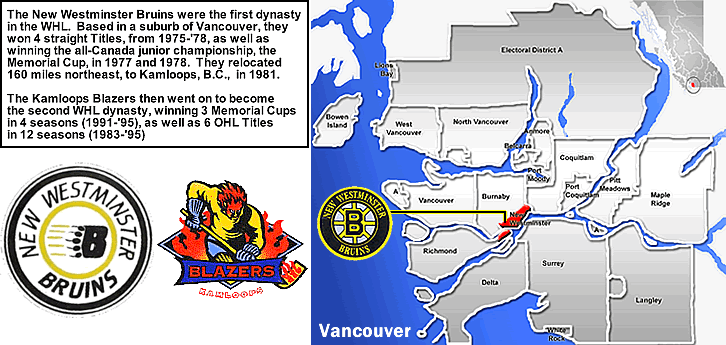Please note: I have made a more recent map-and-post of the WHL (April 2016), here:
Western Hockey League (WHL): location-map with: 2015-16 attendance data, WHL titles & CHL/Memorial Cup titles listed/+ illustrations for the 4 WHL teams with the best attendance in 2015-16 (Calgary Hitmen, Portland Winterhawks, Edmonton Oil Kings, Spokane Chiefs), and the 3 WHL teams with the best-percent-capacity figures in 2015-16 (Kelowna Rockets, Red Deer Rebels, Prince Albert Raiders).
.
.
.
.
.
.
.
.
.
.
.

…
…
The Western Hockey League, or WHL, is one of 3 junior hockey leagues based in Canada. The other 2 leagues are the Ontario Hockey League (OHL); and the Quebec Major Junior Hockey League (QMHJL). [Note: I made a map similar to this one for the OHL, which I posted on January 13th. To see the OHL map, go to Categories, under "Hockey," and scroll down to bottom of page.]
These 3 leagues are for players aged 15 to 20, after which they are eligible for the National Hockey League Draft. All three of the leagues feature teams from the USA; the WHL has a U.S. Division within it’s league format. The other 3 divisions loosely follow the three far western Canadian Provinces (British Columbia, Alberta, and Saskatchewan).
The WHL is currently averaging a very healthy 4,500 per game. This is rather impressive, when one considers that it is a junior hockey league. The biggest minor-league hockey league, the AHL, is only averaging 500 more per game, this season (4,900).
The WHL was formed in 1966, out of the desire to unify the four western Canadian provinces’ junior leagues, in order to better compete with the junior leagues in Ontario and Quebec. Five Sakatchewan teams, the Regina Pats, the Saskatoon Blades, the Estevan Bruins, the Moose Jaw Canucks, and the Weyburn Red Wings, plus the Edmonton Oil Kings and the Calgary Buffaloes were the founding members. Within 5 years, the WHL had reached ascendancy in the west, and when the Canadian Amateur Hockey Association reorganized, in 1971, the WHL became one of the 3 leagues in the top tier of Canadian junior hockey.
There have been 3 dynasties in the WHL. The first was the New Westminster Bruins, who were from the Vancouver area. They started out in Saskatchewan, as the Estevan Bruins (in the southeast of the province, 15 miles from the US border at North Dakota). They moved west to metro Vancouver, in 1971. They won 4 consecutive Titles in the 1970′s, as well as two Memorial Cups (which is the all-Canada junior crown). They moved to Kamloops, British Columbia, in 1981, and went on to become the second WHL dynasty (see below).
The third WHL dynasty has been the central British Columbian team the Kelowna Rockets. They have won 2 WHL titles and a Memorial Cup since 2002. They also draw very well for a small city: around 6,100 for the past 3 seasons.
The Vancouver Giants are the reigning WHL champions. They are also currently the best draw, averaging an impressive 8,700 last season. They lead the turnstile count again this season (at 8,300) , followed by the Calgary Hitmen (at 8,100). Both these teams must compete with an NHL franchise in their cities. This trend, of minor league teams successfully establishing a niche in big-league cities, began in the mid 1990′s, with the formation of the Hitmen. That team reached a peak attendance of 10,000, in 2005.
On the other end of the population spectrum, teams like the Everett Silvertips (30 miles north of Seattle, Washington, USA), and the Red Deer (Alberta) Rebels are thriving. They both drew over 6,000 last season, and are both playing in cities with populations under 95,000. And two teams pull in around 10% of their hometown population: the Brandon (Manitoba) Wheat Kings and the Swift Current (Saskatchewan) Broncos. Brandon is a city of 48,000: the Wheat Kings are drawing 4,100; Swift Current is a town of just 15,000; the Broncos pull in 1,900 per game.
Below is a little map I put together that shows some old logos from the WHL.

The logo at the upper right is the Flin Flon (Manitoba) Bombers. This was a legendary team that produced loads of NHL talent, like Hall of Famer Bobby Clarke {see this, here). That franchise moved, and then became defunct, but another team has inherited the name, and plays in the Sakatchewan Junior Hockey League. The rams-head logo in Montana is the crest of the Billings Bighorns, also defunct. The Victoria Cougars are now up in northern B.C., as the Prince George Cougars. The Kelowna Wings moved to Spokane, and became the Chiefs. All the rest of the logos on this map are of WHL teams still in their same locations.
The Regina Pats emblem has remained unchanged. They have been arouind for 90 years, and are the oldest major junior hockey club in the world. **{see the Regina Pats website, here.} The team was named after the Princess Patricia of Connaught, the granddaughter of Queen Victoria; and they were associated with the Princess Patricia’s Canadian Light Infantry. The Regina Pats still wear that regiment’s crest as a shoulder patch {see the crest, here}.
The WHL is traditionally known a league that produces large, hard-hitting defensemen, and fore-checking power forwards. It is often referred to as “the Dub,” after the first syllable in the WHL.
WHL website: (http://www.whl.ca/hm/).

